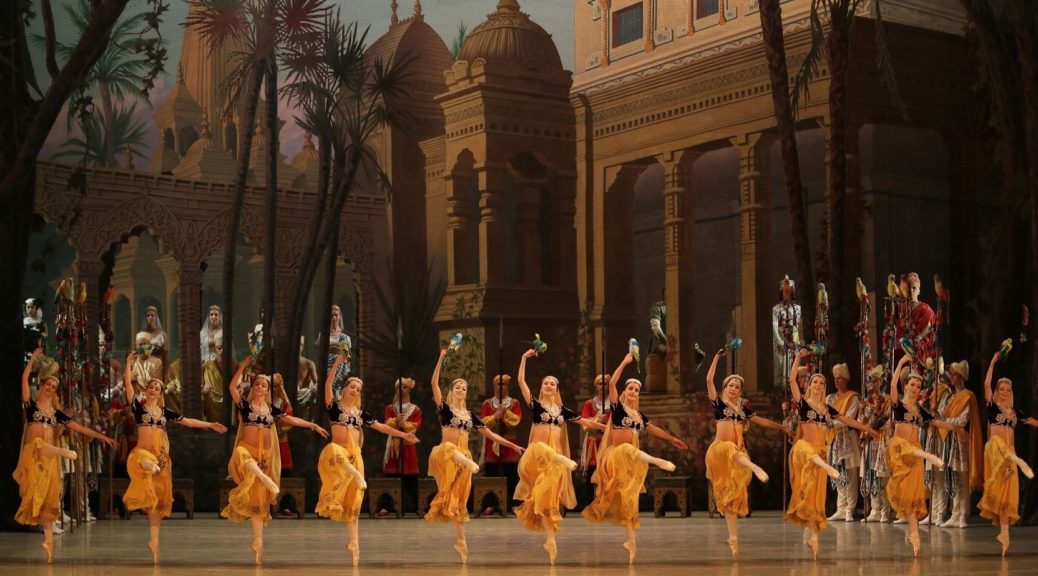
High-Stepping Nonpareil Russians
BERKELEY—The Russians serving up a palatial seven-course ballet feast in “La Bayadère:” Take a Barnum & Bailey spectacular, with oompah circus music to match, and a faux-India of snake charmers and rajahs like Hollywood’s, as ground out in 1920s silent flicks. Add arguably the finest dancers in the world, with a depth of ensemble to rival the Vienna Philharmonic or the New England Patriots. There you have the invincible Mariinsky Ballet out of St. Petersburg, Russia, playing here this week.
It takes your breath away—that is, if you’re still breathing after those mammoth sets and the circus effects (a hunted tiger’s carcass and that “elephant” wheeled on-stage), all extended into three hours and two intermissions.
Women dominate this 1877 Czarist-era classic, dating back partly to the ingenious Marius Petipa’s choreography. Though fundamentally pudding-headed, the handsome hero Solor is sought by two heroines; women’s corps dancers prevail, each time in new costumes; and a spotless white line of 32 perfectly balanced women enter in the hypnotic dream-sequence “Kingdom of the Shades,” the ballet’s most famous scene often excerpted by other large troupes.
Dance, not spectacle, dominates at the forefront, standing delicately on pointe. The refinement of the performers is paramount, right down to the 32ndShade filing on stage. This is a feast of classical performances, despite the many patches, upgrades and alterations done over the centuries by Yuri-come-lately choreographers.
The choice role here is the damsel Gamzatti, whom Solor is forced by the rajah to marry. But your heart goes to the bayadère (temple dancer, usually South Indian) Nikia, his doomed true love, who succumbs to a poison-snake bite from a spray of flowers provided by the malevolent lady Gamzatti. As is almost mandatory in romantic 19th-century ballet, the true heroine returns posthumously for a stunning pas de deux with the hero.
These roles were played by four different trios over six performances here. Each was seemingly better than the previous, with the ladies whipping/turning flawlessly, and the men leaping to the sky. I forwent the ghosts in our streets to catch the ghosts on stage on Hallowe’en, encountering yet another would-be Baryshnikov, thedanseur nobleVladimir Shklyarov, as Solor, opposite the youngest of all the week’s Nikias, Maria Khoreva with her miniscule waist, a sprite who could bend like a reed in the wind. The malicious Gamzatti was Anastasia Nuikina, who would be a superstar with any one of our indigenous troupes.
Incredible? Even more remarkable, the talent-rich Mariinsky can be touring three of its companies abroad simultaneously, while a fourth may be touring Siberia. Of course, this might not be the largest of the groups, with a mere 109 dancers, plus the 68-member all-Russian orchestra, and assorted production-crew personnel. Does any rival anywhere even come close?
The story is of course pure kitsch, marred further by various anachronistic slaves of the rajah bounding about the stage. Matching in kitsch is the score by the emigré composer Ludwig Minkus, a reliable hack who could never have achieved renown in his home town of Vienna. If either the overachieving drummer or the cymbal-crasher were out sick, Minkus’ whole orchestra would shut down.
But wait! A superior male corps of Indians behind a high-leaping dancing drummer take over in a show-stopping, electrifying act-two sequence. And as for Minkus, I’d curl up any time with his high point: the exquisite music featuring solo cello and harp for the intimacy of Nikia’s soliloquy dance near the end of act two—conduct far above and beyond.
DANCE NOTES—Sign of these wildfire times: Two large generators parked behind the building in case of fire-fear power shutdowns. The show must and will go on unless flames are licking at the toe-shoes and scenery. Fortunately they were not required.
“La Bayadère,” performed by the Mariinsky Ballet and Orchestra from Russia, Oct. 31-Nov. 2, Zellerbach Hall, Berkeley. Cal Performances (CP) auspices. For CP info: (510) 642-9988 or go online: www.calperformances.org.